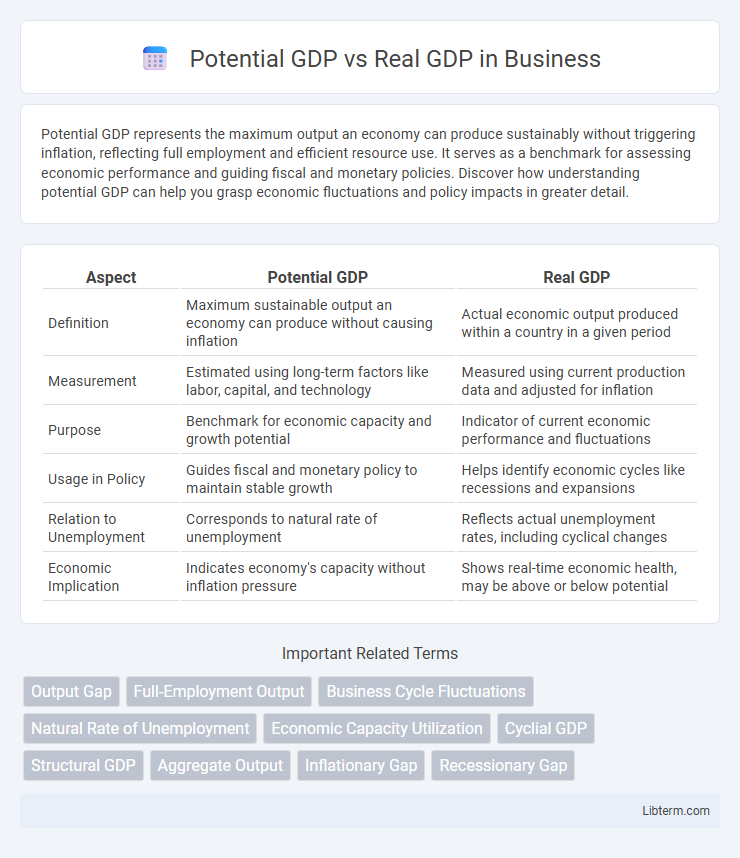Potential GDP represents the maximum output an economy can produce sustainably without triggering inflation, reflecting full employment and efficient resource use. It serves as a benchmark for assessing economic performance and guiding fiscal and monetary policies. Discover how understanding potential GDP can help you grasp economic fluctuations and policy impacts in greater detail.
Table of Comparison
| Aspect | Potential GDP | Real GDP |
|---|---|---|
| Definition | Maximum sustainable output an economy can produce without causing inflation | Actual economic output produced within a country in a given period |
| Measurement | Estimated using long-term factors like labor, capital, and technology | Measured using current production data and adjusted for inflation |
| Purpose | Benchmark for economic capacity and growth potential | Indicator of current economic performance and fluctuations |
| Usage in Policy | Guides fiscal and monetary policy to maintain stable growth | Helps identify economic cycles like recessions and expansions |
| Relation to Unemployment | Corresponds to natural rate of unemployment | Reflects actual unemployment rates, including cyclical changes |
| Economic Implication | Indicates economy's capacity without inflation pressure | Shows real-time economic health, may be above or below potential |
Definition of Potential GDP
Potential GDP represents the maximum sustainable output an economy can produce when utilizing all available resources efficiently without triggering inflation. It serves as a benchmark for assessing economic performance by comparing actual Real GDP against this ideal capacity. Deviations between Real GDP and Potential GDP indicate economic fluctuations such as recessions or overheating.
Definition of Real GDP
Real GDP measures the total value of all goods and services produced within a country's borders, adjusted for inflation, reflecting the actual economic output during a specific period. It provides an accurate representation of economic performance by accounting for price changes, unlike nominal GDP. Real GDP is crucial for comparing economic growth over time and assessing the economy's true production capacity relative to potential GDP.
Key Differences Between Potential and Real GDP
Potential GDP represents the maximum sustainable output an economy can achieve at full employment without triggering inflation, while Real GDP measures the actual economic output adjusted for inflation during a specific period. Key differences include that Potential GDP indicates the economy's capacity based on labor, capital, and technology, whereas Real GDP reflects current economic performance subject to cyclical fluctuations. Divergences between Real and Potential GDP highlight output gaps, signaling recessions when Real GDP falls below Potential GDP or inflationary pressures when Real GDP exceeds it.
Factors Influencing Potential GDP
Potential GDP is primarily influenced by factors such as labor force growth, capital accumulation, technological advancements, and improvements in productivity. Real GDP, on the other hand, fluctuates around potential GDP due to short-term factors like demand shocks, business cycles, and fiscal or monetary policies. Understanding these determinants helps economists gauge the economy's capacity and identify output gaps.
Determinants of Real GDP
Real GDP is primarily determined by factors such as labor force size, capital stock, technological advancements, and productivity levels, all of which drive the economy's actual output within a given period. Unlike Potential GDP, which represents the maximum sustainable output an economy can produce without generating inflation, Real GDP fluctuates due to business cycles, demand shocks, and changes in resource utilization. Measuring Real GDP against Potential GDP helps identify output gaps, signaling underperformance or overheating in the economy.
Economic Cycles and the GDP Gap
Potential GDP represents the maximum sustainable output an economy can achieve without triggering inflation, serving as a benchmark during economic cycles. Real GDP fluctuates above or below this potential level, reflecting expansions or recessions within the business cycle. The GDP gap, calculated as the difference between potential and real GDP, quantifies economic slack or overheating, influencing policy decisions aimed at stabilizing growth and controlling inflation.
Importance of Closing the Output Gap
Closing the output gap, the difference between potential GDP and real GDP, is crucial for economic stability and growth. A smaller output gap indicates the economy is operating near full capacity, reducing unemployment and avoiding inflationary pressures. Persistent gaps signal underutilized resources or overheating, making policy interventions essential to optimize production and maintain long-term economic health.
Policy Implications of GDP Deviations
Deviations between potential GDP and real GDP signal economic gaps that guide fiscal and monetary policy decisions to stabilize growth and control inflation. Policymakers use output gaps to adjust interest rates, government spending, and taxation to either stimulate underperforming economies or cool overheating ones. Targeting the alignment of real GDP with potential GDP helps maintain sustainable employment levels and price stability over time.
Measuring Potential GDP: Methods and Challenges
Measuring Potential GDP involves estimating the maximum sustainable output an economy can produce without triggering inflation, typically using production function approaches, statistical filters, or structural models. Challenges arise due to data limitations, changing technology, labor market dynamics, and capital stock measurement, making accurate potential output estimation complex. Reliable estimates require integrating multiple methods and continuously updating assumptions to reflect evolving economic conditions.
Impact of Potential vs Real GDP on Economic Growth
Potential GDP represents the maximum sustainable output an economy can achieve without triggering inflation, serving as a benchmark for economic growth. Real GDP measures the actual output produced, reflecting current economic performance and short-term fluctuations. When Real GDP exceeds Potential GDP, it signals an overheating economy with inflationary pressures, while Real GDP below Potential GDP indicates underutilized resources and slower economic growth.
Potential GDP Infographic

 libterm.com
libterm.com